Implementing effective classroom management strategies is crucial, particularly in today’s diverse classrooms. With students from various backgrounds, abilities, and learning styles, creating a positive and inclusive learning environment becomes a great challenge. In this blog post, we will explore 20 unique classroom management strategies that you could implement, even in challenging classroom settings. With the goal to foster a supportive atmosphere, engage students, and more, one thing in common remains above all – promoting optimal learning outcomes. Let’s dive in and discover ways to make the learning experience fun and enjoyable!
Understanding the Importance of Classroom Management Strategies
In the bustling world of education, where diverse students bring a myriad of experiences and needs into the classroom, effective classroom management emerges as a vital force. It holds the power to shape not only the educational journey but also the lives of students. By prioritizing classroom management, we create a transformative space where students can thrive, teachers can inspire, and learning can flourish.
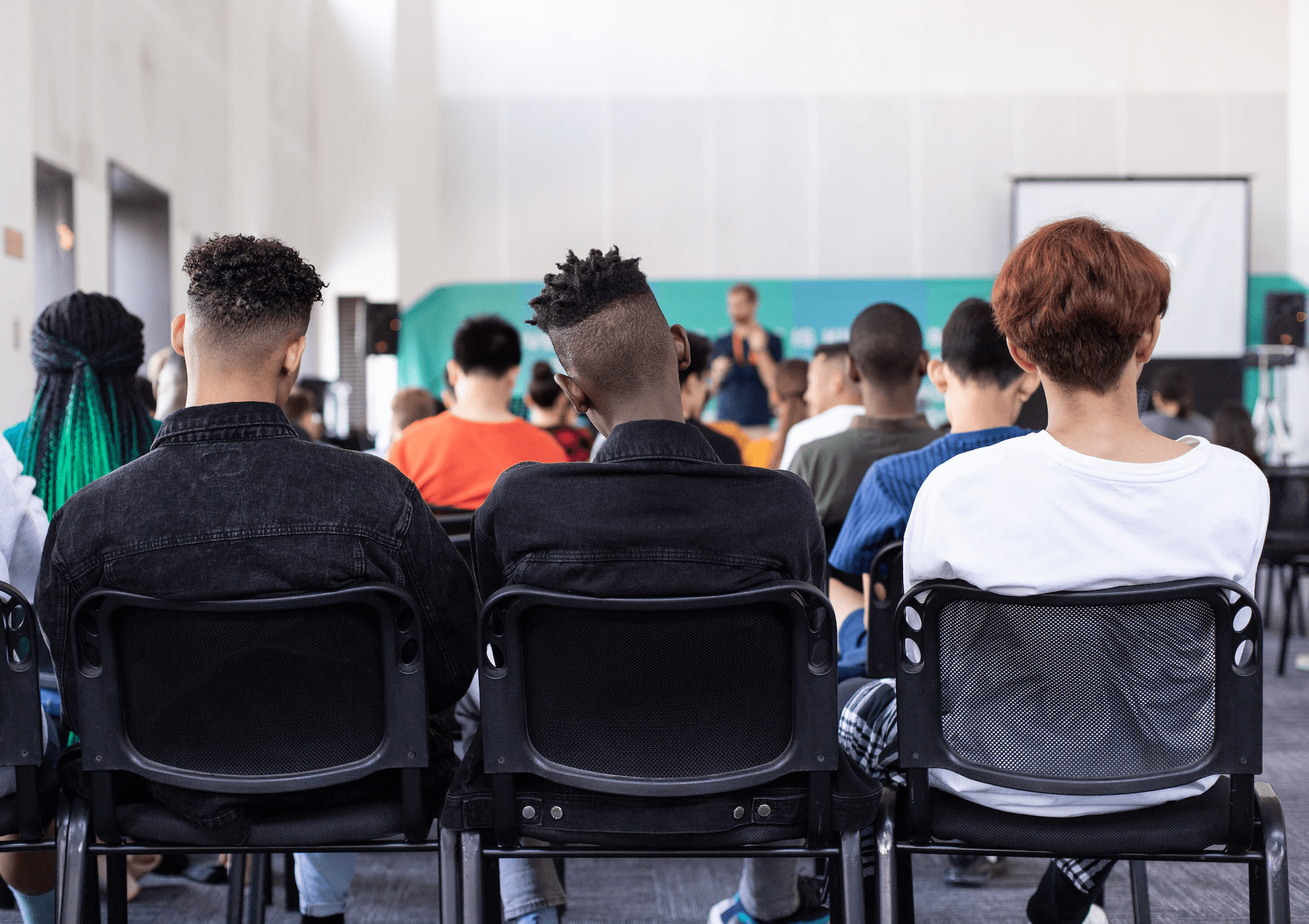
We all understand that the success of a classroom relies on the diverse techniques employed by individual educators to manage their classes. But, have you ever wondered why establishing a solid foundation in effective classroom management is absolutely essential? Doing so can open the door to a world of possibilities, and here are a few key benefits that come along with it:
🌱 Establishing a Positive Learning Environment
Effective classroom management strategies set the foundation for a positive and productive learning environment. When students feel safe, heard, and supported, they are more likely to actively engage in learning, participate in class discussions, and take academic risks.
📚 Maximizing Learning Opportunities
By proactively coming up with new ways to enhance the classroom experience, you create an environment that maximizes learning opportunities for all students. Minimizing disruptions and maintaining a focused atmosphere allows students to concentrate on their studies, absorb information, and achieve their academic potential.
☮️ Fostering Inclusion and Equity
Optimizing classroom management strategies enables you to foster inclusion and equity in your classroom. By implementing fair and consistent practices, you ensure that all students have equal access to educational resources, opportunities, and support. This promotes a sense of belonging and encourages collaboration among diverse student populations.
😇 Developing Social and Emotional Skills
Effective classroom management strategies open up as a platform for developing students’ social and emotional skills. Through clear expectations, positive reinforcement, and conflict resolution strategies, students learn to regulate their emotions, communicate effectively, and work cooperatively with their peers.
🫂 Enhancing Teacher-Student Relationships
When you prioritize classroom management strategies, you establish strong teacher-student relationships based on mutual respect, trust, and understanding. Positive relationships contribute to a supportive classroom climate where students feel comfortable seeking help, expressing their thoughts, and taking intellectual risks.
20 Unique Classroom Management Strategies to Keep Students Engaged
#1 Secret Agent Theme
Imagine your classroom as a thrilling world of spies and turn it into a secret agent adventure where students can earn special badges or ranks based on their behavior and participation. Students become secret agents and can earn cool badges or ranks by showing good behavior and actively participating. Here are some examples of how this theme can be used:
- Behavior Badges
- Each student is given a spy badge with different ranks, like Rookie Agent, Special Agent, or Master Spy. When students follow classroom rules, treat others with respect, and behave well, they can earn these badges as rewards.
- Exciting Missions
- Make class assignments feel like secret missions. For example, a math assignment can become a mission to solve equations and decode hidden messages. Students who successfully complete these missions can level up their ranks or unlock special privileges.
- Code Breaking Challenges
- Introduce coding or puzzle challenges where students have to crack secret codes and ciphers. They can work alone or in teams to develop their problem-solving and critical thinking skills.
- Spy-themed Rewards
- Offer spy-themed rewards as incentives for achievements. These can include spy gadgets, secret decoder rings, or personalized spy notebooks. Students can earn these rewards by reaching higher ranks, completing missions, or putting in exceptional effort.
- Physical Challenges
- Create fun physical challenges, like obstacle courses or treasure hunts, within the secret agent theme. Students can work together, solving clues and overcoming obstacles, to earn points or rewards. This encourages teamwork and collaboration.

#2 Virtual Travel
Transform your classroom into an exciting virtual travel experience, where students embark on a journey around the world without leaving their seats. With the Virtual Travel theme, students can earn “passport stamps” as they complete assignments or exhibit positive behavior, immersing themselves in diverse cultures and landmarks. This strategy encourages curiosity, global awareness, and rewards students’ achievements.

- Personalized Passports
- Provide each student with a personalized passport to track their progress and decorate. Students earn passport stamps when they successfully complete assignments, demonstrate good behavior, or achieve specific goals. These stamps symbolize the countries or landmarks they “visit” during their make-believe travels.
- Explore Countries and Destinations
- Throughout the school year, introduce various countries and destinations to your students. Display country profiles or posters highlighting key information like geography, history, culture, and landmarks. Incorporate this knowledge into lessons or hold dedicated “travel” sessions where students explore and learn about a specific country.
- Assignments as Travel Missions
- Frame assignments as travel missions linked to the featured country or destination. For example, if you’re exploring Japan, students could research Japanese culture or create presentations about famous Japanese landmarks. Encourage creativity and provide opportunities for students to share their work with the class.
- Virtual Tours and Technology
- Enhance the virtual travel experience by incorporating technology. Take students on virtual tours of famous landmarks, museums, or natural wonders through online platforms or pre-recorded videos. Engage them by asking questions and facilitating discussions during these virtual tours.
- Hands-on Cultural Activities
- Organize hands-on activities that allow students to experience the culture of the countries they “visit.” Encourage them to try traditional crafts, taste international snacks, or learn basic phrases in different languages. These activities foster cultural understanding and appreciation.
- Milestones and Rewards
- Set milestones based on the number of passport stamps students collect. Celebrate their progress by rewarding them with small tokens related to the featured countries, such as stickers, postcards, or bookmarks. Create a “travel wall” where students can proudly display their accomplishments.
#3 Mystery Box
Engage your students with an element of mystery and excitement through the Mystery Box strategy. This strategy involves using a special box filled with small prizes or rewards that students can earn by demonstrating good behavior or achieving academic milestones. The Mystery Box adds an element of anticipation and motivation to the classroom environment, encouraging students to strive for success.

- Behaviors and Achievements
- Clearly define the behaviors and achievements that will earn students a chance to pick from the Mystery Box. It could be anything from completing homework on time, actively participating in class discussions, exhibiting kindness towards classmates, or achieving specific academic goals. Make sure the criteria are transparent and consistent.
- Intriguing Presentation
- Present the Mystery Box as a visually appealing and intriguing object to capture students’ attention. Decorate the box with enticing designs or wrapping paper to build anticipation and make it a focal point in the classroom. Consider adding a sense of mystery by placing a “question mark” or a small teaser on the box’s exterior.
- Random Selection Process
- Determine a fair and random selection process for choosing students who get to pick from the Mystery Box. It could involve drawing names from a hat, using a random name generator, or employing a rotating schedule. Ensure that every student has an equal chance to earn rewards from the box.
- Variety of Prizes
- Fill the Mystery Box with a variety of small prizes or rewards that appeal to your students. These can include items like stickers, stationery, small toys, bookmarks, or even privilege cards that grant special privileges in the classroom. Consider including a mix of instant rewards and “big-ticket” items to maintain excitement.
- Celebrate Success
- When a student earns the opportunity to pick from the Mystery Box, celebrate their achievement in front of the class. Acknowledge their hard work, positive behavior, or academic accomplishments. Encourage the student to share their success with their peers, fostering a positive and supportive classroom community.
#4 Class Olympics
Get ready to ignite a sense of friendly competition and teamwork in your classroom with the exhilarating Class Olympics strategy. This strategy involves organizing a class Olympics event where students can participate in a range of academic and physical challenges, earning points for their teams or themselves. By incorporating elements of teamwork, goal-setting, and healthy competition, the Class Olympics foster a positive and engaging learning environment.
- Team Formation
- Divide your class into teams, encouraging a mix of abilities and strengths within each group. Consider assigning team names and colors to create a sense of identity and camaraderie among students.
- Academic Challenges
- Design a series of academic challenges that align with your curriculum and encourage critical thinking, problem-solving, and knowledge retention. These challenges can include quizzes, debates, puzzles, creative projects, or presentations. Each successful completion of an academic challenge earns points for the respective team or individual.
- Physical Challenges
- Incorporate physical activities into the Class Olympics to promote physical fitness, coordination, and teamwork. These challenges can include relay races, obstacle courses, scavenger hunts, or team-building activities. Students earn points based on their performance in these challenges.
- Points System
- Establish a points system to track each team’s or individual’s progress throughout the Class Olympics. Assign specific point values to different challenges, ensuring that both academic and physical achievements are recognized. Display a visual scoreboard in the classroom to build excitement and encourage friendly competition.
- Awards and Recognition
- Plan for awards and recognition at the conclusion of the Class Olympics. Consider certificates, medals, or trophies for the winning team or individual with the highest overall points. Additionally, acknowledge and celebrate individual accomplishments, such as the most improved student or the most enthusiastic participant.
#5 Random Acts of Kindness
Cultivate a culture of kindness and empathy in your classroom with the heartwarming Random Acts of Kindness strategy. This strategy aims to encourage students to perform thoughtful and selfless acts of kindness, while also fostering a sense of gratitude and appreciation for one another. By recognizing and rewarding these acts, you can inspire students to spread positivity and make a difference in the lives of others.

- Kindness Log
- Provide students with a special notebook or journal where they can record their acts of kindness. Encourage them to write down the date, the act of kindness they performed, and how it made them and others feel. This log serves as a personal reflection and reminder of the positive impact they are making.
- Classroom Discussion
- Initiate regular classroom discussions about kindness and its significance. Encourage students to share their experiences and stories of acts of kindness they have witnessed or received. Use these discussions to explore the importance of empathy, compassion, and the ripple effect of kindness.
- Recognition and Appreciation
- Create a system to recognize and appreciate students for their acts of kindness. This can include shout-outs during class, sharing their stories with the class, or displaying a kindness bulletin board where students’ acts of kindness are showcased. Consider nominating a “Kindness Ambassador” each week or month, who can highlight exceptional acts of kindness.
- Reward System
- Implement a reward system to further incentivize acts of kindness. This can involve a point system where students earn points for each act of kindness recorded in their logs. Accumulated points can be redeemed for small rewards or privileges, such as a homework pass, a special classroom job, or a kindness-themed certificate.
- Community Outreach
- Extend the acts of kindness beyond the classroom by involving students in community service projects or collaborations with local organizations. This could include volunteering at a shelter, organizing a donation drive, or participating in a community clean-up initiative. Engaging in acts of kindness towards the wider community reinforces the importance of making a positive impact on the world.
#6 Class Newsletter
Unleash the creativity and communication skills of your students with the engaging Class Newsletter strategy. This strategy involves assigning students the role of a class journalist, allowing them to take turns creating a weekly or monthly newsletter that showcases positive achievements and events within the classroom. By giving students the opportunity to share and celebrate their accomplishments, you foster a sense of pride, teamwork, and effective communication among your students.
- Newsletter Roles
- Assign different students as the class journalist for a specific period, such as a week or a month. Rotate the role so that every student gets a chance to be the class journalist. This allows them to develop their writing skills, creativity, and responsibility in curating the newsletter content.
- Positive Achievements
- Encourage students to gather information about positive achievements within the classroom. This can include academic accomplishments, creative projects, acts of kindness, or sports achievements. The newsletter should serve as a platform to recognize and celebrate the successes and efforts of students.
- Event Highlights
- Highlight upcoming events, field trips, special projects, or classroom activities in the newsletter. This not only keeps the students informed but also generates excitement and anticipation. Include details about the purpose, date, and expectations for each event, ensuring that the entire class remains engaged and involved.
- Student Contributions
- Encourage students to contribute articles, stories, poems, or artwork to the newsletter. This allows them to showcase their unique talents and interests, fostering a sense of ownership and pride in their work. Students can write about topics they are passionate about or share their personal experiences related to classroom activities.
#7 Reward Coupons
Motivate and reward your students with the exciting Reward Coupons strategy. This strategy involves designing and distributing personalized reward coupons that students can redeem for special privileges or small treats. By offering these coupons as incentives, you create a positive reinforcement system that encourages positive behavior and academic achievements. Here are some ways to implement this strategy effectively:
- Coupon Design
- Create visually appealing coupons that reflect the desired rewards. Use colorful designs, illustrations, and catchy phrases to make the coupons attractive and enticing for students. Consider including spaces for students’ names and the date of redemption to personalize the coupons.
- Reward Options
- Determine a variety of rewards that students can choose from when redeeming their coupons. These rewards can include privileges like sitting in a special chair, choosing a preferred activity, extra free time, or small treats like a piece of candy, a sticker, or a special pencil. Tailor the rewards to suit the interests and preferences of your students.
- Coupon Distribution
- Establish a system for distributing the reward coupons. You can hand them out individually when students demonstrate exemplary behavior or achievement, or you can implement a token-based system where students earn coupons by accumulating points or meeting specific goals. Ensure that the distribution process is fair and consistent to maintain a positive and equitable classroom environment.
- Redemption Guidelines
- Clearly communicate the guidelines for redeeming the reward coupons. Establish specific rules, such as the number of coupons required for each reward or the time and place for redemption. Make sure students understand the expectations and follow the process to ensure a smooth and organized system.
#8 Interactive Learning Stations
Transform your classroom into an engaging and interactive learning environment with the Interactive Learning Stations strategy. This approach involves setting up various learning stations around the classroom that allow students to explore and engage with different subjects or topics in a hands-on and interactive way. Here’s a breakdown of the key elements and benefits of implementing this strategy:
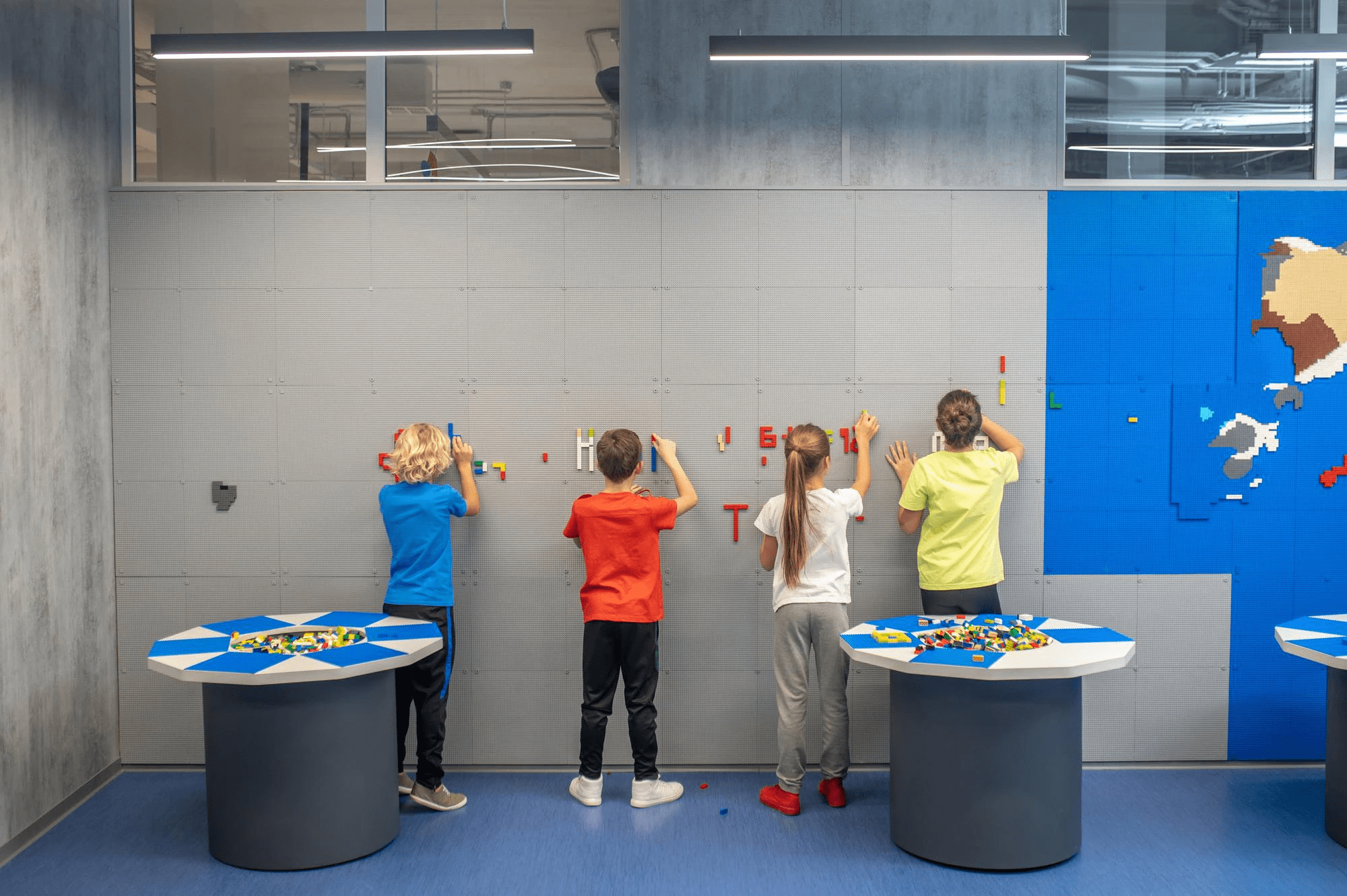
- Station Design
- Create visually appealing and organized stations dedicated to specific subjects or topics. Equip each station with relevant materials, resources, and activities that align with the learning objectives. Utilize labels, signs, or visual cues to guide students to the different stations effectively.
- Hands-on Activities
- Provide interactive and hands-on activities at each station to encourage active learning and exploration. These activities can include experiments, puzzles, manipulatives, simulations, or interactive digital tools. Ensure the activities are age-appropriate, engaging, and aligned with the curriculum.
- Rotational System
- Establish a rotational system that allows students to move from one station to another at specified intervals. This ensures that all students have the opportunity to explore each station and receive a well-rounded learning experience. Use timers, signals, or designated transition times to manage the rotations smoothly.
#9 Class Auction
Introducing the Class Auction strategy, a fun and engaging way to motivate students through a unique economic twist. In this approach, students have the opportunity to participate in a class auction where they can bid on desirable items or privileges using classroom currency they earn through demonstrating good behavior and achieving academic milestones. Let’s delve into all the ways you can make this happen:
- Auction Setup
- Prepare for the class auction by selecting a variety of enticing items or privileges that students can bid on. These could include small toys, books, art supplies, or special privileges like being the line leader or choosing the class activity. Display the items in an appealing manner, creating a sense of anticipation and excitement.
- Classroom Currency
- Establish a system for students to earn classroom currency, such as earning points for good behavior, completing assignments, or achieving academic goals. Assign a specific value to each currency unit to determine the bidding power of students during the auction. This currency system reinforces positive behavior and motivates students to actively participate.
- Bidding Process
- Explain the rules and procedures of the auction to the students. Provide them with an opportunity to preview the items or privileges available for bidding. Set a clear starting bid for each item and guide students through the bidding process, allowing them to place their bids using their accumulated classroom currency. Encourage strategic thinking and decision-making as students decide how much currency to spend on each item.
- Auction Dynamics
- Facilitate an interactive and engaging auction experience. Encourage students to raise their hands or use designated bidding paddles to place their bids. Create a lively atmosphere by incorporating an auctioneer role, using a gavel, or playing background music. Ensure that the bidding process remains fair and transparent, allowing all students an equal chance to participate.
- Winner Selection
- Once the bidding for an item or privilege is complete, announce the highest bidder as the winner. Recognize their successful bid and award them the item or privilege they won. If multiple students are interested in the same item, consider implementing a system that allows for alternative or shared winners, promoting cooperation and negotiation skills.
#10 Role Reversal Day
Prepare for an exciting and transformative strategy: Role Reversal Day! This innovative approach empowers students by giving them the opportunity to become the teachers and take charge of their own learning. During this special day, students step into the role of instructors and share their knowledge with their classmates. More on how you can take the lead in implementing this into the classroom:

- Preparation
- Set aside dedicated time for students to prepare their lessons. Guide them in selecting a topic or subject they feel confident in teaching. Encourage them to plan engaging activities, create visual aids, and gather resources to support their teaching.
- Guidance and Support
- Provide students with guidance and support as they prepare their lessons. Offer assistance in structuring the content, creating effective lesson plans, and developing teaching materials. Ensure they have access to relevant resources, such as textbooks, online materials, or educational tools.
- Classroom Management
- Establish clear expectations and guidelines for classroom behavior on Role Reversal Day. Emphasize the importance of respect, active participation, and attentiveness from both the “teachers” and the “students.” Remind students of their responsibility to create a supportive and inclusive learning environment.
- Peer Feedback
- Encourage students to provide constructive feedback to their peers after each teaching session. This feedback can focus on strengths, areas for improvement, and suggestions for enhancing the learning experience. Peer feedback promotes reflection, growth, and mutual support among students.
- Integration with Curriculum
- Look for opportunities to integrate Role Reversal Day into the existing curriculum. Align the topics chosen by students with the curriculum objectives, allowing them to reinforce their understanding of the subject matter and deepen their knowledge through teaching.
#11 Escape Room Challenge
Here, we have the thrilling Escape Room Challenge strategy, where students embark on an immersive adventure within the classroom, solving puzzles and riddles related to the subject matter to “escape” from a locked room. This strategy promotes critical thinking, teamwork, and problem-solving skills. Here’s how you can implement the Escape Room Challenge:
- Theme and Setting
- Choose a captivating theme that aligns with the curriculum or specific learning objectives. Create an engaging and visually appealing setting within the classroom, using props, decorations, and appropriate lighting to set the atmosphere.
- Puzzles and Challenges
- Design a series of puzzles, riddles, and challenges that require students to apply their knowledge, skills, and critical thinking abilities. Ensure that the puzzles are age-appropriate, progressively challenging, and relevant to the subject matter being taught.
- Team Formation
- Divide students into small teams, encouraging diversity and collaboration. Assign roles within each team, such as a leader, a note-taker, a timekeeper, and a problem solver. This promotes teamwork, communication, and effective delegation of tasks.
- Clues and Guidance
- Provide students with clues or hints when they encounter difficulties. These clues can be obtained by solving additional puzzles or by demonstrating understanding of the subject matter. Ensure that the clues are strategically placed to guide students toward the correct solutions.
- Time Limit and Progress Tracking
- Set a time limit for the Escape Room Challenge to add excitement and urgency. Display a visible timer in the room to keep teams aware of the remaining time. Track the progress of each team to monitor their performance and offer assistance if needed.
#12 Classroom Currency
Let’s dive into the Classroom Currency strategy, a dynamic system that engages students by creating a virtual economy within the classroom. Through this strategy, students earn and spend classroom currency to acquire various items or privileges, fostering a sense of responsibility, motivation, and real-world financial skills. Here’s how you can implement the Classroom Currency system:
- Currency Design
- Create a unique name and design for the classroom currency. It could be coins, dollars, or any other creative representation. Develop colorful and visually appealing currency templates that can be printed and distributed to students.
- Earning Currency
- Define a set of criteria or behaviors that allow students to earn classroom currency. This can include academic achievements, good behavior, participation, completing assignments, or demonstrating positive character traits. Establish clear guidelines and expectations to ensure fairness and consistency.
- Currency Exchange
- Determine a conversion rate for exchanging classroom currency into rewards or privileges. For example, students can accumulate currency over time and exchange it for tangible rewards like small prizes, extra free time, preferred seating, or intangible privileges like choosing a classroom activity or leading a discussion.
- Classroom Economy
- Introduce a system where students can spend their earned currency. Create a classroom store or auction where students can purchase items or experiences using their accumulated currency. These items can include school supplies, books, toys, or even special privileges like becoming a line leader for the day.
- Reflection and Evaluation: Periodically evaluate the effectiveness of the Classroom Currency system. Seek feedback from students to understand their perspectives and suggestions for improvement. Reflect on how the system impacts student motivation, behavior, and engagement in the classroom.
#13 Class Pet
Ever heard of the the Class Pet strategy? It’s a delightful way to foster responsibility and empathy among students by having a furry or feathery friend as a part of the classroom community. The Class Pet provides an opportunity for students to take turns caring for the pet and earn rewards for their responsible pet care.

- Selecting the Pet
- Choose a suitable class pet based on factors such as the age group of students, classroom environment, and any relevant regulations or restrictions. Popular options include small animals like hamsters, fish, or reptiles, but make sure to consider allergies and student preferences.
- Pet Care Schedule
- Create a pet care schedule where each student or group of students is assigned a specific day or week to take care of the class pet. Responsibilities may include feeding, cleaning the habitat, ensuring the pet’s well-being, and providing appropriate enrichment activities.
- Establishing Care Guidelines
- Clearly communicate care guidelines to students, ensuring they understand how to handle the pet safely and meet its basic needs. Provide written instructions, demonstrations, and opportunities for students to ask questions to ensure the well-being of the pet.
- Rewards for Responsible Care
- Implement a reward system to incentivize responsible pet care. Students can earn rewards, such as special privileges, extra free time, or the opportunity to spend additional time with the class pet, for fulfilling their pet care duties diligently and responsibly.
- Pet-related Activities
- Plan pet-related activities that engage students and promote their connection with the class pet. These can include observing the pet’s behavior, creating artwork inspired by the pet, writing stories or journals about their interactions, or even inviting guest speakers like veterinarians or animal experts to share their knowledge.
#14 Creative Classroom Jobs
Oh, this is a personal favorite – the Creative Classroom Jobs strategy, a fun and engaging approach to promote student ownership and responsibility within the classroom. By assigning unique and creative job titles to students, such as “Director of Fun,” “Chief Organizer,” or “Inventor Extraordinaire,” you empower them to take on specific responsibilities related to their roles. Here’s how you can implement the Creative Classroom Jobs strategy:

- Job Selection
- Begin by brainstorming a list of creative job titles that align with various tasks and responsibilities within the classroom. Consider the needs of your classroom community and the interests and strengths of your students. Allow students to express their preferences for specific roles, ensuring a fair and inclusive selection process.
- Job Descriptions
- Create job descriptions for each role, clearly outlining the tasks, responsibilities, and expectations associated with the job. Provide students with a comprehensive understanding of what their role entails, as well as any specific guidelines or deadlines they need to follow.
- Rotating Roles
- To provide opportunities for all students to experience different roles, establish a rotation system where students switch jobs periodically. This ensures that everyone has a chance to take on different responsibilities and develop a diverse skill set.
- Recognition and Rewards
- Acknowledge and celebrate the efforts and contributions of students in their assigned roles. Highlight their accomplishments during class discussions, recognize their achievements through certificates or badges, or allocate special privileges or rewards for exceptional performance.
#15 Interactive Technology
Out with the old, in with the Interactive Technology strategy, a dynamic approach to enhance student engagement and motivation through the integration of interactive technology tools in the classroom. By incorporating educational apps, online platforms, and other interactive tools, you can create an immersive and interactive learning experience for your students. See how easily you can incorporate interactive technologies in the classroom:
- Explore Educational Apps and Platforms
- Research and explore a variety of educational apps and online platforms that align with your teaching goals and subject matter. Look for tools that offer interactive features, gamification elements, and real-time feedback to keep students actively engaged in the learning process. With the fast-changing landscape of technology, be sure to keep an eye out for AI-powered ones that could easily increase your day-to-day productivity by a mile!
- Integrate Interactive Quizzes
- Utilize interactive quiz tools to create engaging assessments and formative feedback opportunities. These quizzes can be customized to suit the learning objectives and difficulty level of your students, promoting active participation and knowledge retention.
- Collect Real-time Audience Responses
- Use interactive polling tools to gather real-time feedback from students during lessons. This allows you to gauge student understanding, identify areas of improvement, and adjust your teaching accordingly.
- Gamify Learning
- Implement gamification elements into your lessons to make learning more enjoyable and motivating. Create leaderboards, award points, or provide virtual rewards to recognize student achievements and encourage healthy competition.
- Enhance Presentations with Interactive Features
- Utilize interactive presentation tools that allow students to interact with the content directly. This can include drag-and-drop activities, clickable elements, or multimedia integration to provide an immersive learning experience.
Good news – the world of EdTech is bursting with countless options, just like a grocery store aisle. If you’re looking for a one-app-fits-all tool, then you should definitely give ClassPoint a try!
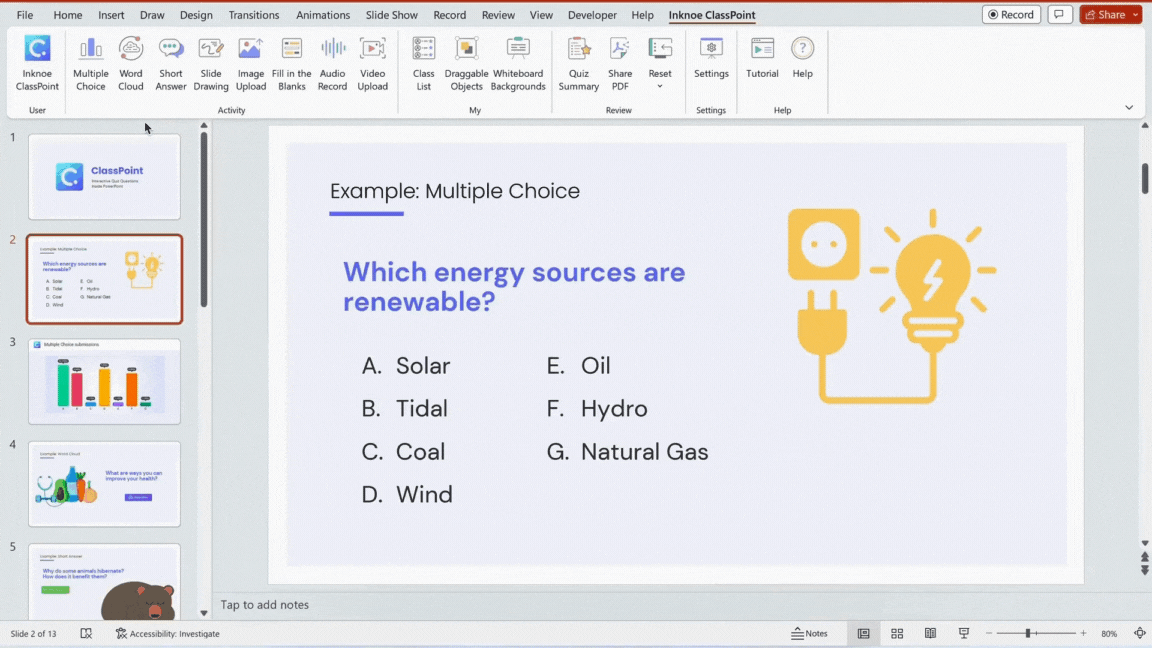
ClassPoint revolutionizes the way you teach by seamlessly integrating into Microsoft PowerPoint, elevating your presentations to a whole new level. With its comprehensive set of features, including interactive quizzing tools, advanced annotations during slide shows, an automated reward system, and AI-assisted technology, ClassPoint transforms your classroom into an engaging and efficient learning environment. Don’t miss out on the opportunity to enhance student engagement, motivation, and overall teaching effectiveness with ClassPoint!
#16 Virtual Reality
Buckle your students up for a ride with the Virtual Reality Experiences strategy, a captivating way to transport students to new places and provide immersive learning opportunities through the use of virtual reality (VR) headsets or 360-degree videos. With this strategy, students can embark on virtual field trips, explore historical landmarks, dive into the depths of the ocean, or even visit outer space without leaving the classroom.
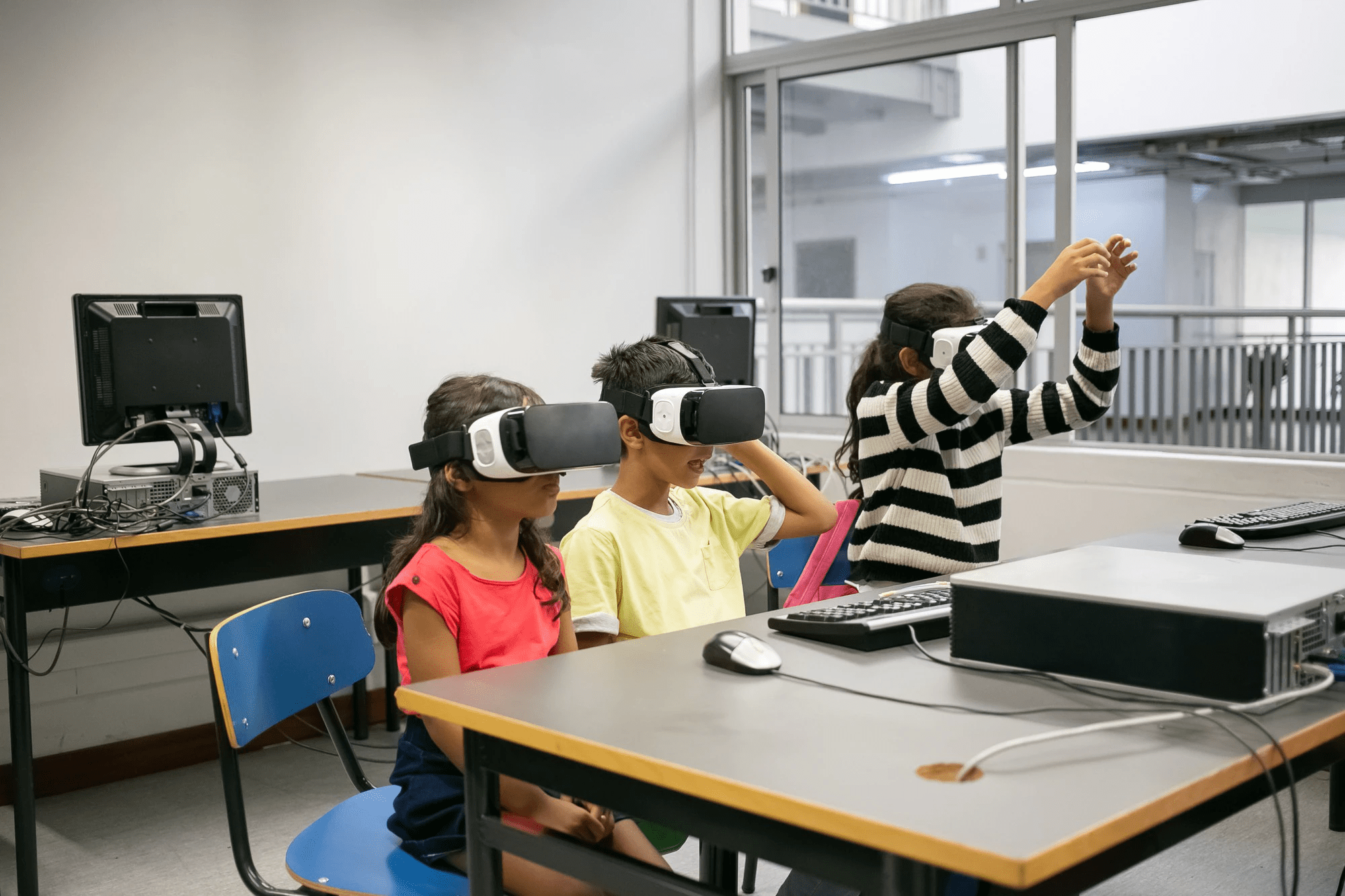
- VR Equipment and Software
- Acquire VR headsets or utilize 360-degree video platforms that are compatible with your classroom technology. Ensure the headsets are age-appropriate, comfortable, and provide a safe and immersive experience. Familiarize yourself with the VR software and content available for educational purposes.
- Curating Virtual Experiences
- Explore a wide range of VR experiences and 360-degree videos relevant to your curriculum or topics of interest. Look for content that aligns with the learning goals and engages students in a meaningful way. Virtual field trips, historical reconstructions, cultural explorations, and scientific simulations are just a few examples.
- Guided Exploration and Reflection
- Provide guidance during the VR experiences by offering prompts or questions that encourage students to actively observe, reflect, and engage with the content. After the virtual experience, facilitate discussions or reflective activities to deepen their understanding and connections to the real-world applications of what they have seen.
- Student-Created Content
- Encourage students to create their own 360-degree videos or VR experiences. They can research and plan a virtual tour, develop a scientific simulation, or create interactive storytelling experiences. This empowers students to become creators and further enha
#17 Collaborative Projects
It’s time to try the Collaborative Projects strategy, a dynamic approach to fostering teamwork, problem-solving, and creativity among students. With collaborative projects, students have the opportunity to work together in groups, tackling real-world challenges or engaging in innovative ventures. Here are some among the many ways you hack yourself into this strategy:
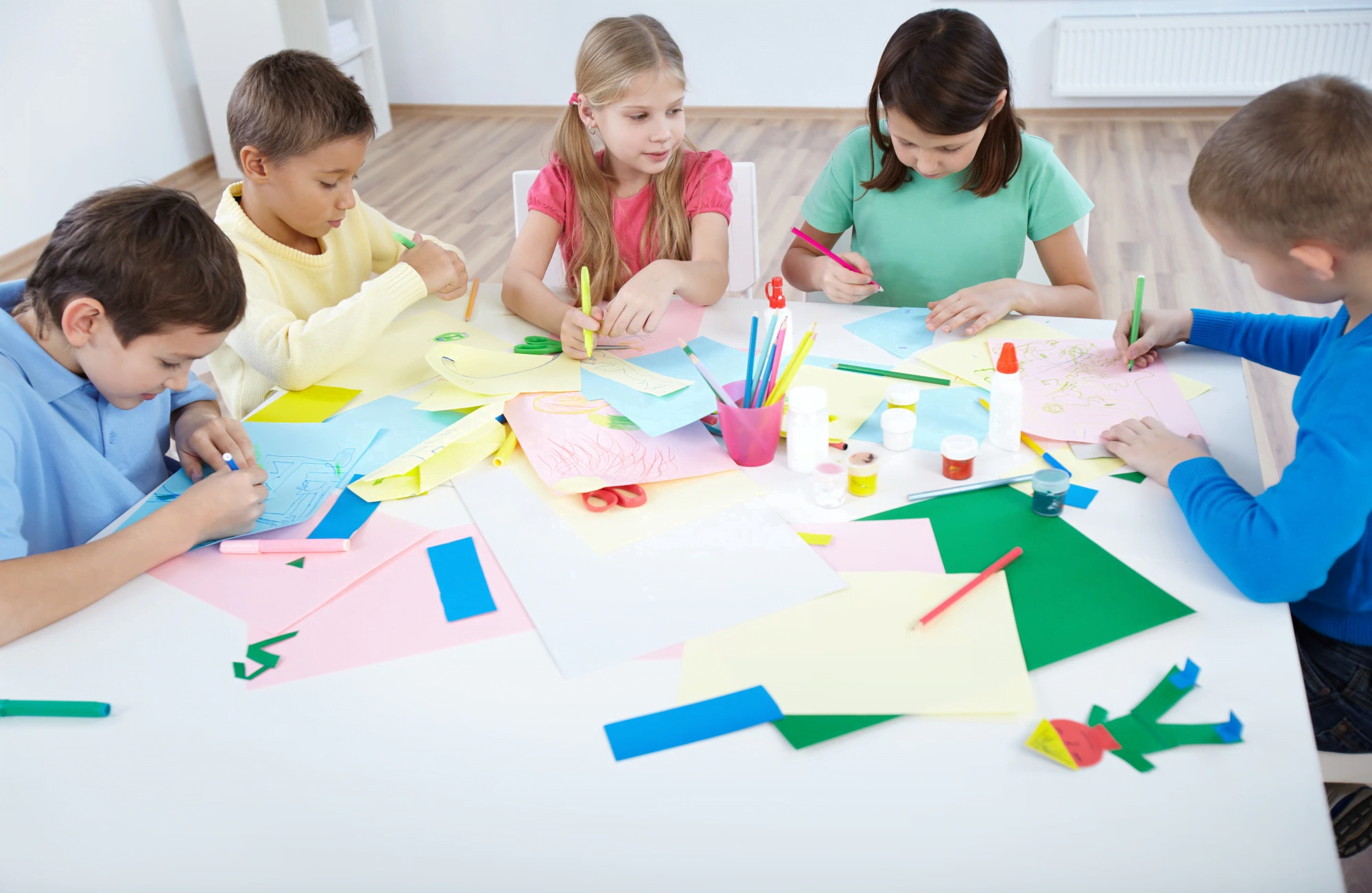
- Project Selection
- Choose projects that align with your curriculum objectives and encourage critical thinking, collaboration, and creativity. Consider topics that are relevant and meaningful to students, allowing them to apply their knowledge and skills in practical ways. Projects could range from designing sustainable solutions to local environmental issues, creating a multimedia presentation on a historical event, or developing a prototype for a useful invention.
- Group Formation
- Form groups strategically, considering factors such as diverse skill sets, interests, and personalities. Aim for balanced group dynamics, promoting a mix of leadership, creativity, and problem-solving abilities. Consider incorporating both individual and group accountability to ensure equal participation and contributions.
- Presentations and Celebrations
- Plan opportunities for groups to showcase their collaborative projects to the class, school, or community. This could involve presentations, exhibitions, or demonstrations where students share their solutions, insights, or innovations. Celebrate the accomplishments of each group, recognizing their efforts and the valuable skills they have developed throughout the project.
#18 Classroom Challenges
Liven up the classroom from routinary classroom set-ups with the Classroom Challenges strategy, a captivating way to motivate students and encourage them to achieve specific goals in various subjects. Classroom challenges provide an exciting framework for students to engage in activities that enhance their skills and knowledge while earning rewards along the way. Here’s how you can implement the Classroom Challenges strategy:

- Challenge Selection
- Choose challenges that align with your curriculum and learning objectives. Consider subjects like reading, math, science, or even creative projects. Ensure the challenges are appropriately challenging yet attainable, catering to the diverse abilities and interests of your students. For example, a reading challenge could involve reading a certain number of books within a specific timeframe, while a math challenge could focus on solving a set of complex problems.
- Clear Goals and Guidelines
- Clearly define the goals and guidelines of each challenge. Communicate the specific criteria for successful completion, such as the number of books to be read, the accuracy of math solutions, or the completion of a creative project. Make sure the goals are measurable and provide a sense of accomplishment when achieved.
- Tracking Progress
- Implement a system to track students’ progress throughout the challenges. This could involve a chart, a digital platform, or individual progress logs. Allow students to visually see their progress and the progress of their peers, creating a sense of friendly competition and motivation.
- Variation and Extension
- Keep the challenges fresh and engaging by introducing new variations or extensions. This could include different levels of difficulty, collaborative challenges, or interdisciplinary challenges that combine multiple subjects. Allow students to suggest their own challenge ideas, promoting ownership and creativity.
#19 Positive Affirmations
Nothing that a little kindness couldn’t fix! The Positive Affirmations strategy is a powerful way to uplift and motivate students at the beginning of each class, fostering a positive tone and mindset for the day ahead. Positive affirmations are simple, empowering statements or inspirational quotes that affirm students’ worth, abilities, and potential. Easily foster the culture for positivity with these ways:

- Daily Affirmation Ritual
- Begin each class by dedicating a few minutes to positive affirmations. This ritual sets the tone for the day, creating a supportive and encouraging environment for students. You can lead the affirmation session or invite students to take turns sharing their favorite affirmations.
- Choose Inspiring Affirmations
- Select a variety of positive affirmations that resonate with your students. Consider affirmations that promote self-confidence, resilience, growth mindset, kindness, and perseverance. Ensure the affirmations are age-appropriate and relevant to your students’ needs and interests. You can find a wealth of affirmations online or create your own based on your knowledge of your students.
- Share Personal Stories
- Enhance the impact of affirmations by sharing personal stories or examples related to the affirmation’s theme. For instance, if the affirmation is about resilience, share a story of someone who overcame challenges through perseverance. This personal touch helps students connect with the affirmations on a deeper level.
- Visual Displays
- Create visual displays of affirmations in the classroom to serve as constant reminders. Display them on bulletin boards, posters, or whiteboards where students can easily see and reflect upon them. You can even encourage students to contribute their own affirmations or decorate the displays to make them visually appealing.
- Reflective Activities
- Engage students in reflective activities that reinforce the affirmations’ messages. For example, you can ask students to write journal entries about how a specific affirmation resonates with them or how they have applied it in their lives. This encourages introspection and helps students internalize the positive messages.
- Affirmation Cards
- Create individual affirmation cards that students can keep with them throughout the day. These can be small cards with an affirmation written on one side and a visually appealing design on the other. Students can refer to these cards whenever they need a reminder of their strengths and potential.
#20 Mindfulness Moments
Keep it all together with the Mindfulness Moments strategy, a valuable approach to incorporate mindfulness and relaxation techniques into your daily classroom routine. Mindfulness is the practice of intentionally bringing attention to the present moment with an attitude of openness and non-judgment. By integrating mindfulness moments into your teaching, you can help students cultivate focus, reduce stress, and enhance their overall well-being. More on how you can nail this:
- Start with Guided Meditation
- Begin each class or transition with a short guided meditation. This can involve guiding students through a series of calming breaths or leading them in a relaxation exercise. There are various resources available, including recorded guided meditations or scripts you can use as a guide.
- Practice Breathing Exercises
- Teach students simple breathing exercises that promote relaxation and focus. One example is the “4-7-8” technique, where students inhale deeply for four counts, hold their breath for seven counts, and exhale slowly for eight counts. Encourage students to practice these breathing exercises during transitions or whenever they feel the need to center themselves.
- Incorporate Mindful Activities
- Integrate mindful activities into the curriculum to engage students in the present moment. For example, you can incorporate mindful coloring, sensory awareness exercises, or mindful eating activities. These activities provide opportunities for students to practice mindfulness while also enhancing their creativity and sensory awareness.
- Create a Calming Corner
- Designate a specific area in the classroom as a calming corner. This space can include comfortable seating, soft lighting, and resources like mindfulness books, sensory tools, or quiet activities. Encourage students to utilize this space when they need a moment to pause, reflect, or engage in a calming activity.
- Model Mindfulness
- Be a role model for mindfulness by practicing it yourself. Demonstrate the techniques, share your experiences, and highlight the benefits of mindfulness. When students see you embracing mindfulness, they are more likely to engage and explore these practices themselves.
Conclusion
In conclusion, implementing effective classroom management strategies can greatly enhance the learning environment and promote student engagement, motivation, and positive behavior. By creating a classroom atmosphere that is fun, interactive, and supportive, you can foster a sense of community and empower your students to thrive academically and socially.
It’s important to remember that effective classroom management is not a one-size-fits-all approach. Continuous assessment to students’ needs, interests, and learning styles is a must to select the strategies that align best with your classroom dynamics. Additionally, adapting and customizing these strategies based on student feedback can further enhance their effectiveness.
As educators, we have the power to create a positive and nurturing environment where students can thrive and reach their full potential. By implementing these classroom management strategies, we can create a space that inspires curiosity, fosters collaboration, and cultivates a love for learning in our students. Together, let’s make the classroom a place where students feel valued, engaged, and empowered to become lifelong learners.